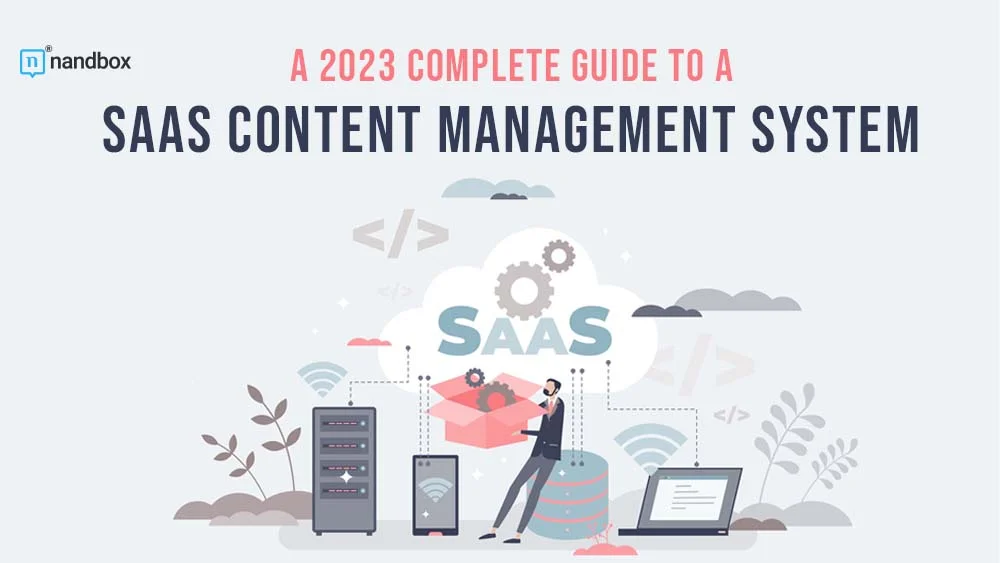The Ultimate 2023 Guide to SaaS Content Management Systems
Businesses are striving now that technology has taken us to a whole new level of evolution. Every business owner out there wants to prove their online presence. Furthermore, attract more people to get to know their business and use the services they’re offering. In order for you to achieve such a presence, you have to use certain tools. That is to facilitate the whole procedure for yourself. That is why we come to you with the perfect solution, which is a SaaS content management system.
This guide will take you through a SaaS content management system tour. Moreover, we will give you new ways to streamline your business operations and improve your online presence. If you’re looking to stay competitive in the market, we’ve got you! We will provide you with all the information you need to know about SaaS content management systems in 2023.
What Is a SaaS Content Management System?
A software application known as a SaaS Content Management System (CMS) enables businesses to produce, manage, and publish digital content. Ones such as web pages, blog entries, and social network updates from a single platform. This type of CMS is also known as a content management system (CMS). SaaS content management systems (CMS) are a modern alternative to more traditional CMS. Which require organizations to host and maintain their own software. Integrating next.js CMS framework can significantly enhance the efficiency and performance of your SaaS content management system. By leveraging its powerful features such as server-side rendering, static site generation, and seamless API integration, you can ensure a fast, scalable, and flexible platform that meets the dynamic needs of your users.
On the other hand, since the provider hosts and maintains SaaS CMS solutions, businesses are free to focus on content creation. Additionally, on publication rather than technical issues. Subscription-based content management systems (CMS), often known as software as a service (SaaS) solutions, allow organizations to gain access to the underlying software. That is by paying a regular monthly or annual cost.
SaaS CMS Versus On-Premises CMS
On-premise content management systems are those that are placed on servers on the company’s premises or in a private cloud. This indicates that firms are responsible for purchasing or renting costly gear and assembling an IT team to operate the program. The IT staff is also accountable for the system’s maintenance and upgrades, as well as for ensuring that the system is both secure and scalable moving forward.
On-premises hosting has always been the default for many content management systems. However, while this does allow more control over the program, it does not encourage the flexible and creative alternatives to content management that are feasible with a SaaS solution. These methods are viable because SaaS solutions are cloud-based.
With a software-as-a service (SaaS) solution, the software provider is in charge of all responsibilities related to software and hardware maintenance and upgrades. Because the vendor will guarantee a specific amount of uptime in accordance with a service level agreement (SLA), customers do not need to be concerned about scalability. Concerns regarding up-front expenses and ongoing maintenance are typically lower for customers of software-as-a service providers.
Only a browser for the internet is required for users to gain access to SaaS solutions. While this does have some positive effects, such as lower prices and quicker execution times, it also has some negative effects, such as a lack of customization options.
The Many Types of SaaS CMSs
SaaS content management systems are a great way to create an online presence without having to incur exorbitant developer expenses. Look at the various types:
- Open-source vs. closed-source: An open-source CMS can be downloaded for free at first and accessed online. The cost of customization, support, instruction, add-ons, plugins, and other services varies. A closed-course CMS, on the other hand, typically employs proprietary code and necessitates purchasing a license to use it or paying monthly or annual fees for support and updates. Open-source software examples include Kentico, Pulse CMS, and Joomla. ButterCMS, Rivista, Haven Nexus, and Metro Publisher are examples of closed-source legacy content management systems.
- Traditional content management systems: offer everything from a content database to a presentation layer for publishing, with a technical design that firmly integrates the frontend and the backend.
- Headless CMS: Headless CMS is yet another subset of SaaS CMS. Without a front-end layer, a headless CMS is a back-end system that organizes and manages your content. Let’s explore it further below using ButterCMS as an illustration.
The Benefits a SaaS Content Management System Offers
Why use a SaaS CMS in the first place? There are several benefits to a SaaS content management system. Below, you’ll find some of these benefits to help you have a better understanding of the whole concept.
Cost-Effective: This Tool Offers You Lower Costs at It’s Best!
Users are not required to pay a significant licensing cost in advance while utilizing a SaaS content management system (CMS) because the software is based on a subscription basis. The majority of the time, a SaaS content management system project will require a nominal setup charge that will cover the expense of a fundamental deployment.
IT Staff with Fewer Tasks
What does that mean? Well, this means that using a SaaS CMS will help you have an unburdened development team with flexibility they will appreciate. When a support issue arises, your internal IT employees will no longer feel the responsibility of taking care of it. Instead, your SaaS provider will handle any problem that may arise, and in most cases, at no additional expense to you. Additionally, the SaaS provider is responsible for all of the upgrades and maintenance work.
An Enhanced Rate of Accessibility
A software-as-a-service (SaaS) content management system is a “virtual” product, which means that it can typically be accessed from any computer, tablet, or mobile device so long as there is an internet connection. Additionally, team members can work remotely, collaborate on the same documents, and access the latest versions of files and assets.
A SaaS Content Management System Can Help You Expand Easily
If you adopt a model that is based on SaaS, you will be able to simply add new members as your team expands and as your content requirements expand. In a similar vein, if you wish to spin up new sites such as micro-sites, campaign sites, landing pages, etc., adding extra sites is as simple as clicking a button whenever you want to do so. In a model with numerous users and multiple sites, your cost is based on the total number of people who can access the system across all of those locations. Therefore, you will only be charged for the services that you use.
Updated Software

It all comes down to the point that most SaaS CMS can help you have up-to-date features applied without having any extra costs. You can depend on this management system to help you provide all of your users with the latest features and innovations at no additional cost, as we mentioned.
The Speed of Implementation
Since the CMS has already been set up on the underlying cloud infrastructure, the process of launching a new website is more expedient than it has ever been. Your development, quality assurance, and production sites do not require any setup or configuration. Because of this, the development time for a SaaS content management system is significantly less than that of a conventional website or mobile application. This helps you save time and use it to focus on your website’s efficiency.
Every Pro Has a Con: A List of Disadvantages That a CMS Has
There are some potential disadvantages that might come with using a SaaS content management system. Here’s a list of what you might encounter as cons or disadvantages:
Internal Control Absence
It may take some time for IT departments or teams to adjust to a new system in which SaaS CMS platforms are constructed and stored on cloud infrastructure. This is due to the fact that IT departments are so accustomed to having full internal system control.
Closed Development: An Open-Source Struggle
SaaS Content Management System platforms are frequently proprietary, completely under the control of the vendor, and as a result, they do not allow for the use of an open-source development model. Crafter Cloud is a Private SaaS/PaaS content management system (CMS) solution that takes advantage of the open-source development of CrafterCMS. This makes it a significant outlier in the industry.
Since a multi-tenant infrastructure is, by definition, shared across all users, a software as a service (SaaS) solution does not provide extensive customization (for example, it does not permit changes to the code that runs on the back end). To reiterate, Crafter Cloud stands out as a significant outlier within the sector. We provide a one-of-a-kind development environment that is safe, segregated, and secure. This environment enables developers to execute any kind of bespoke programming using Java, the Groovy scripting language, and/or Node.js without giving up the benefits of a SaaS model. So your organization can deliver really unique, branded, and personalized experiences.
A Vendor Lock-In: What We Consider A SaaS CMS Net Trap
The potential for becoming locked in with a single vendor is one of the risks associated with using software-as-a-service (SaaS) solutions. These kinds of problems might arise when a company places an excessive amount of faith in the exclusive technologies provided by a single software provider. If this is the case, switching to a different vendor without incurring major development expenditures may be extremely challenging, if not impossible altogether. Because of this, you need to do everything in your power to steer clear of falling into the SaaS trap.
Key Features to Look For in a SaaS CMS
When searching for a suitable SaaS content management system, there are a few essential features to look for. First things first, make sure the platform is user-friendly and has a clean and simple layout that is easy to understand and manage. Look for a content management system (CMS) that gives you a wide variety of editing choices so you can modify the platform to meet all of your requirements. Make sure that the content management system (CMS) has powerful analytics and reporting tools so that you can monitor how well your material is performing and base decisions about your content strategy on the results of this monitoring. In conclusion, you should search for a content management system (CMS) that has robust security features, such as encryption and consistent backups, to guarantee the safety of your content.
How to Choose the Right SaaS CMS for Your Business
It is possible that selecting the appropriate SaaS CMS for your company will prove to be a challenging undertaking. Yet it is essential to make the appropriate choice in order to assure the success of your content management strategy. To begin, it is important to assess your unique requirements and objectives, including the size of your team, the level of difficulty of your content, and your financial constraints. After that, do some research and analysis of the many SaaS content management system (CMS) providers available to find the one that most closely matches your specifications. Remember to think about things like how simple it is to use, how scalable it is, and how well it integrates with other products and platforms.
Top SaaS CMS Providers in 2023
As the market for SaaS content management systems continues to grow, there are several top providers to keep an eye on in 2023. Some of the most popular options include WordPress, HubSpot, Wix, and Squarespace. Each of these platforms offers unique features and benefits, so it’s important to carefully evaluate your options before making a decision. Consider factors like pricing, customization options, and customer support when choosing the right SaaS CMS for your business.
Final Thoughts
Now that you know the essentials regarding a SaaS content management system, you should be able to use all the top platforms correctly and know which of them will benefit your business. Speaking of benefiting your business, one of the most effective ways that you can empower your business is by having an application for it. Applications are the language everyone is speaking in this digital era. That is why it is crucial that you have one for your business to strengthen your market roots.
If you wish to create an app for your business in a hassle-free manner, nandbox’s native no-code app builder will definitely be the right solution for you! Sign up now for our native no-code app builder and build an application from scratch without having to use a single line of code. Simply customize one of our pre-made templates, drag-and-drop your desired features, and voila! You have an app ready to compete in the app store market. Sign up now and create your app with us for a fraction of the cost.






